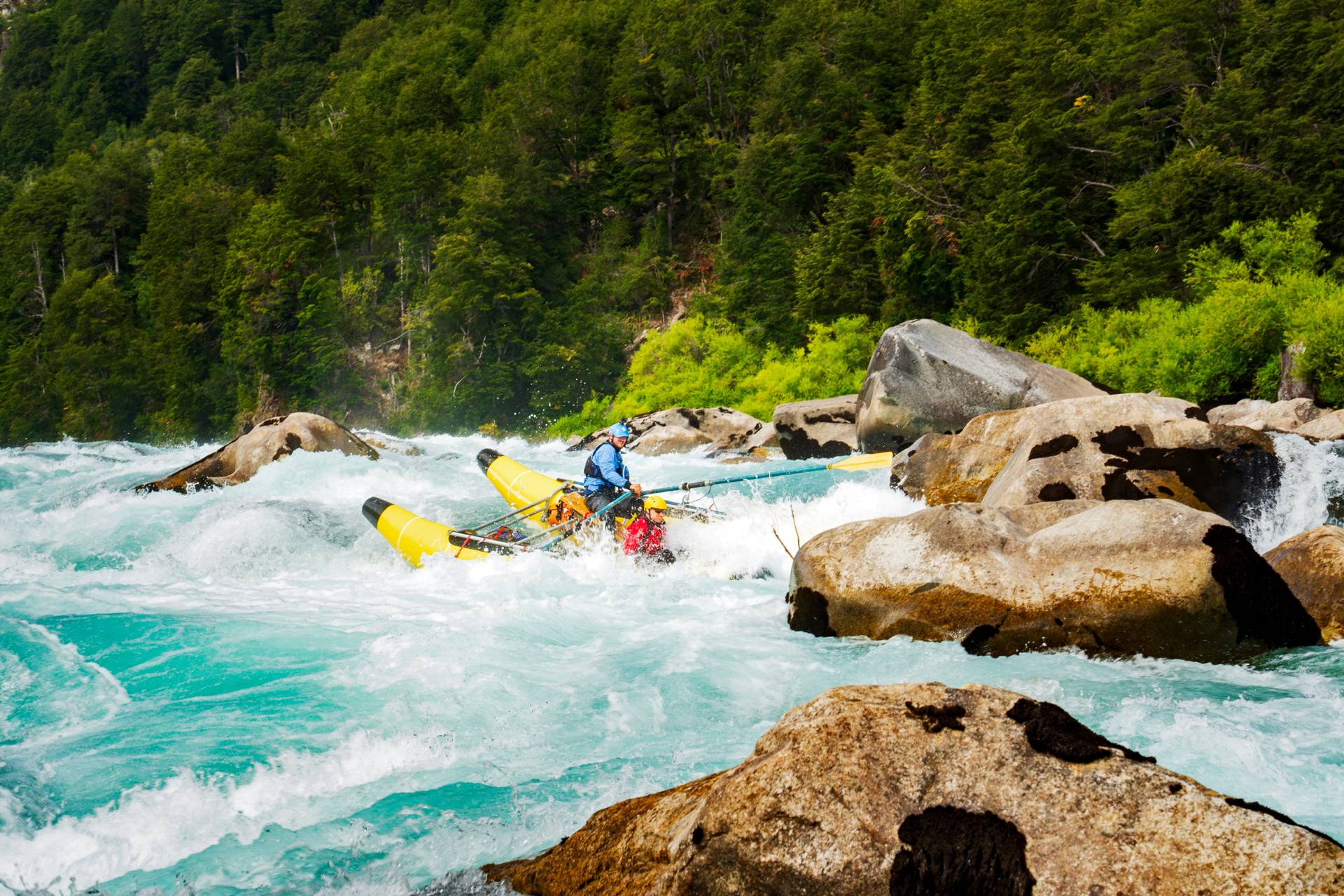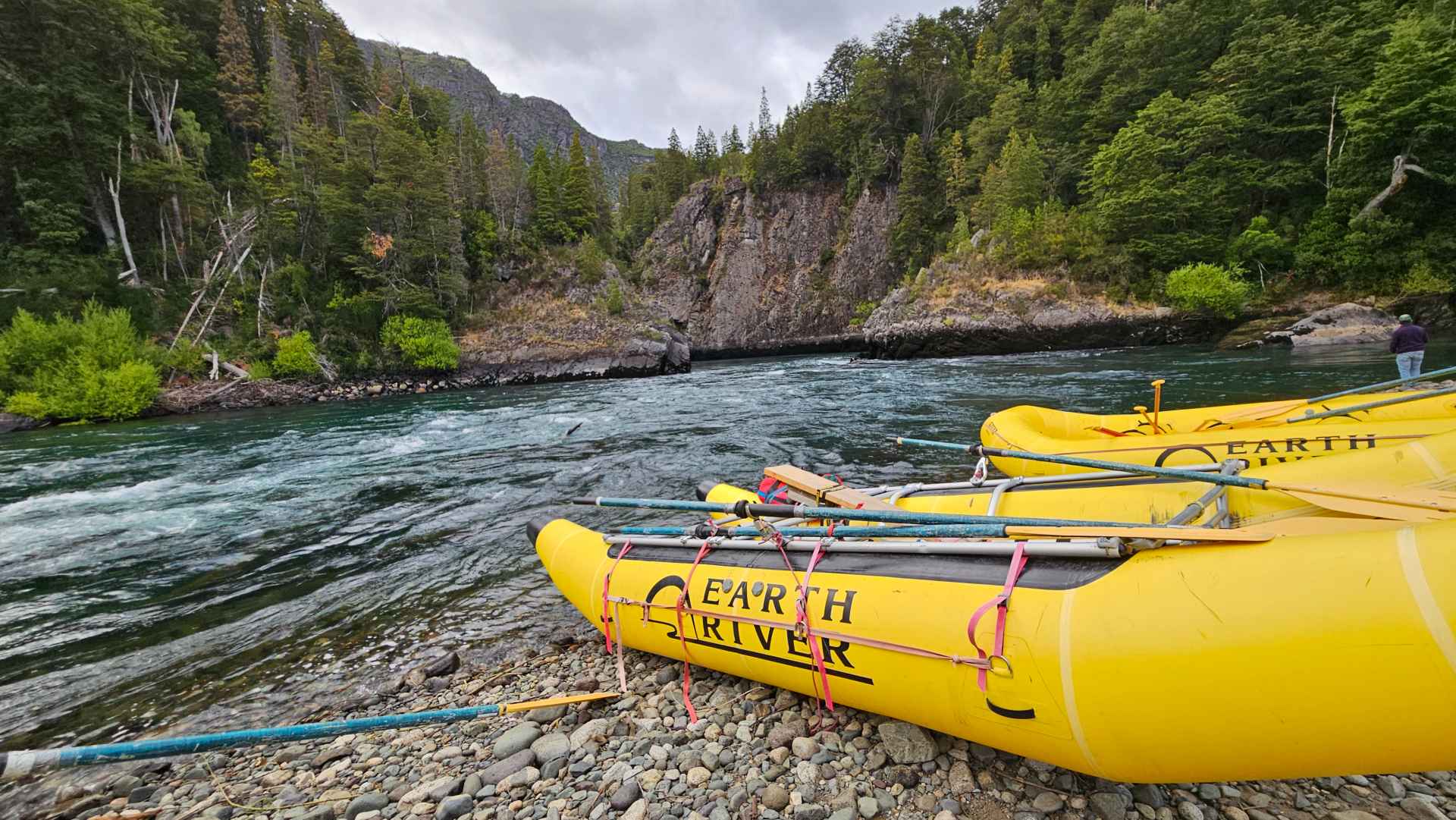How An Expedition in Nepal changed safety on the Futaleufu.
The early 1990s marked the beginning of commercial rafting on the Futaleufu. Our brochure listed the river as a serious whitewater expedition. Thorough guest vetting started in the office. Participants were required to be in excellent physical condition, of a certain age, and to have previously run a challenging whitewater river. Getting down the river took a week, as more time was spent scouting rapids than in the boats. There was no option to walk or be driven around difficut sections and no time for additional multi-sport activities.
Once participants reached the river, they did a compulsory flip drill and a two-hour whitewater training session which ended with a mandatory swim test. Rather than float on their backs with their feet up in a defensive position, swimmers were instructed to do the crawl and “self-rescue”. At the time, safety kayaks were the industry standard for rescuing people on difficult rivers.
 If We Can’t Protect Our Clients, What Are We Doing Here?
If We Can’t Protect Our Clients, What Are We Doing Here?
I was guiding the second raft on one of these early Futaleufú trips in 1993. We pulled over to look from shore at the first rapid in sheer-walled Inferno Canyon. We decided to run one boat at a time. I watched as the first boat missed the line slightly and flipped. One by one, the safety kayakers grabbed the swimmers. By the time everyone was rescued, they were downstream and out of sight. The sheer walls made it impossible for the kayakers to come back up and set safety for us. Attempting to evacuate my group from the canyon was riskier than running the rapid without protection. Reluctantly, I ran the rapid. The incident—and the dilemma it presented—preoccupied me, and I contemplated giving up the Futaleufu altogether.
An Incident That Solved The Saftey Riddle Of The Futaleufu
Later that year I traveled to Nepal to do a trip on the recently opened Karnali River. Dave Allardice, whose company Ultimate Descents pioneered a number of rivers in Nepal, invited me to join one of his expeditions. With a small army of local sherpas carrying the gear, we trekked three days through the Nepalese lowlands to the put-in. I brought an agile, stable two-pontoon cataraft to row from the U.S.. The trip was uneventful until the final day, when a small raft carrying a guide and a client entered a minor rapid on the wrong side of the river.
The trip was uneventful until the final day, when a small raft carrying a guide and a client accidentally entered a minor rapid on river right—the wrong side of the river—where the swift current began sweeping them toward a hollowed-out wall on a 90-degree left bend. Their only recourse from being sucked under the wall was to catch a small eddy of still water carved into the wall directly upstream of the treacherous spot. The strong current made it impossile to paddle the raft out of the eddy and back across the river without being stuffed under the wall. In all my years of guiding I had never seen a situation like this. They were safe but trapped.
 The rest of us pulled over on the other side to survey the situation. The cliff above them was too high to climb and there was no way to reach them with a rope. The only option was to send a safety kayaker into the eddy and one by one ferry them back across.
The rest of us pulled over on the other side to survey the situation. The cliff above them was too high to climb and there was no way to reach them with a rope. The only option was to send a safety kayaker into the eddy and one by one ferry them back across.
The safety kayaker caught the eddy. With the client in the water, holding onto the back of his kayak, he pulled into the current. The passenger created so much drag that the swift current instantly began sweeping them toward the undercut wall. The kayaker quickly retreated back into the eddy. It was possible that a helicopter could drop a basket down, but we were a long way from civiliaztion and helicopters were scarce. This was also years before the advent of the satellite phone.
As a last resort, I volunteered to try with my cataraft. After catching the eddy, they abandoned the raft and climbed on to my cataraft tubes. I had them lie on their stomachs and raise their feet out of the water. Using a sharp upstream angle, I charged into the current. Unlike the kayak, the cataraft—unburdened by drag—easily maintained the upstream ferry angle, allowing me to pull away from the wall and cross. In that serendipitous moment the “safety cataraft” was born.
Safety Catarafts introduced On The Futaleufu
When I returned home, I ordered two large catarafts and designed custom rowing frames with elevated ‘scoop’ decks at the front, positioned just a few inches above the water. With this setup up the “safety cats” could wait below a rapid and if there were swimmers they could be rowed upstream against the current and scoop them up. In some cases the guide wouldn’t even have to let go of the oars. One cataraft was capable of rescuing multiple swimmers at a time and if necessary even negotiate a downstream rapid.
 On the first trip of the 1994 season we entered Inferno Canyon with a charter group from Atlanta that had done the Bio Bio River with us the year before. We were still trying to figure out safe water levels, but without gauges, high water cutoffs were a combination of educated guessing and intuition. The safety cats hadn’t been tested so I added two safety kayakers. I rowed one of the safety catarafts.
On the first trip of the 1994 season we entered Inferno Canyon with a charter group from Atlanta that had done the Bio Bio River with us the year before. We were still trying to figure out safe water levels, but without gauges, high water cutoffs were a combination of educated guessing and intuition. The safety cats hadn’t been tested so I added two safety kayakers. I rowed one of the safety catarafts.
At the second rapid, safety tean ran first and we waited for the client rafts in the pool below. The sheer walls and swift current guarding the entrance made it impossible to scout the hard-to-miss, giant center curling back wave. Nowadays, the guides have everyone get down, and with the lower center of gravity, the rafts easily break through the main wave without incident.
The guest boats entered “train style,” one after another, a practice we abandoned after this trip. One raft flipped and the other stood up and dumped out half it’s occupants. Chaos ensued as we converged on the eight swimmers. I found myself yelling at the kayakers to get out of my way so I could reach the people. The other cataraft and I managed to collect everyone before the next rapid. The “Safety Cataraft” had been inaugurated.
 Dedication To Safety
Dedication To Safety
Earth River’s commitment to client safety didn’t begin or end with the invention of the safety cataraft. It’s something ingrained in our 35-year history and has been passed down to my sons, Cade and Teal, who guide every trip. If you join an Earth River trip, regardless of your age or ability, it will be evident in the first rapid that you’re in good hands.”
By Eric Hertz
